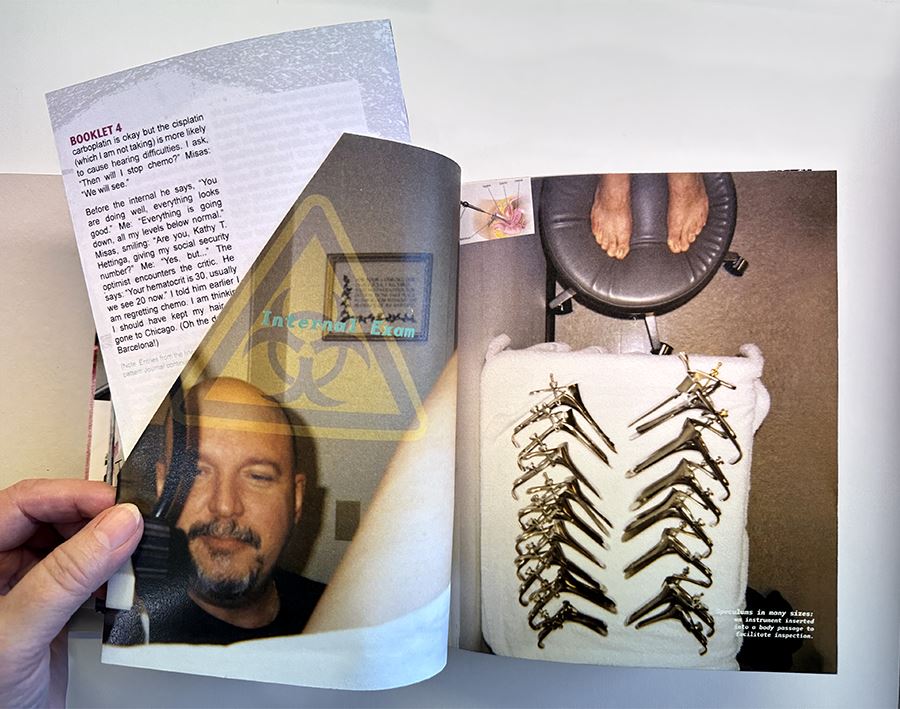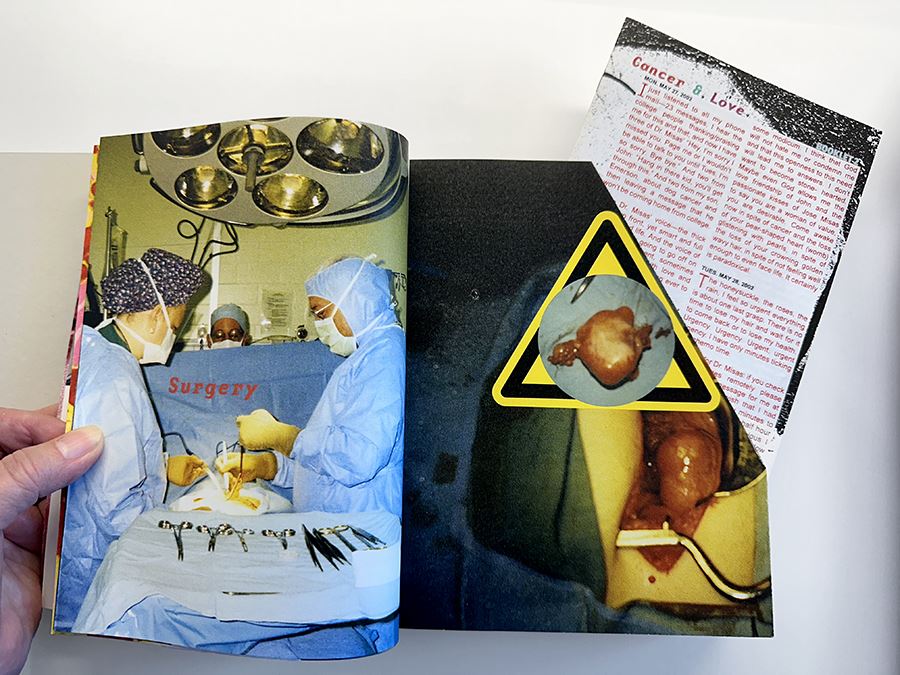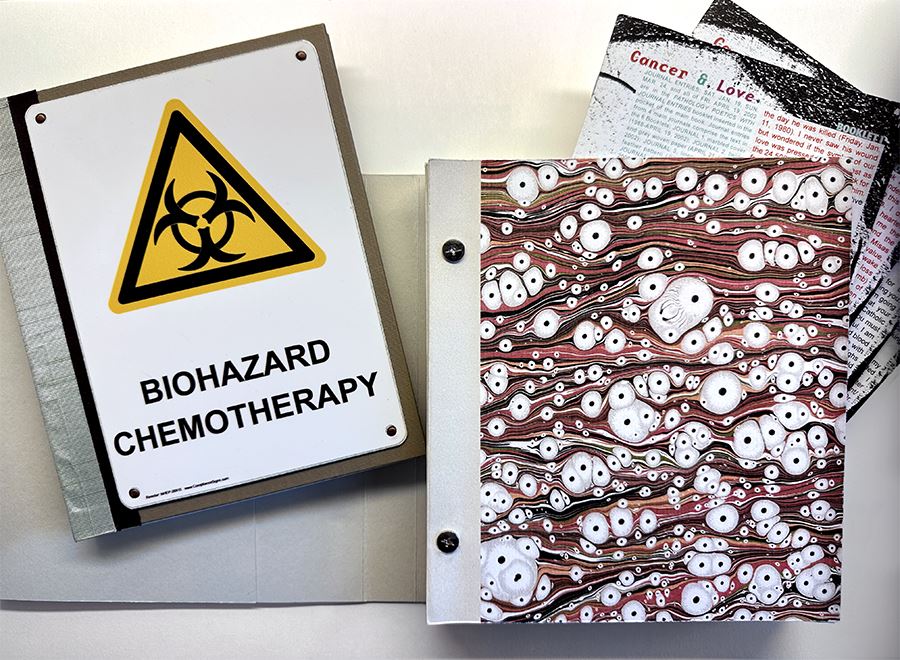I am grateful for the collaborative work of Tate Shaw and his decision to publish Cancer & Love as a VSW Press book. As I mentioned in Part I, the book began during the start of the COVID pandemic, necessitating a long-distance collaboration. During the lockdown, I experienced expanses of productive time, married with long gestational periods. Tate’s description of his work as that of ‘midwifery’—helping the artist to birth their vision—is aptly true for Cancer & Love.

Cancer & Love, Kathy T. Hettinga, French-fold Mohawk Superfine, 7x7.75, with 5x7 booklet.
Below Tate describes his work as editor: “As the current editor of VSW Press, I consider myself less an editor and more a facilitator of artists’ visions for a publication made with available means. When I’m selecting or inviting an artist to publish a book with VSW, I’m conscious of how the work is in dialogue with—or making completely new additions to—the themes and perspectives found in the roughly six hundred titles published by the Press, founded by Joan Lyons in 1971. About 85% of the Press’ catalog was published by Joan. Women telling their own stories through images and texts (including diaries) to make books about being women, lovers, bodies, having health events and encounters with the healthcare industry, all are present in that history. Connected to Cancer & Love, specific past titles from VSW Press that come to mind are Joan’s own book The Gynecologist and Susan E. King’s Treading the Maze.

Cancer & Love, Kathy T. Hettinga, French-fold Mohawk Superfine, 7x7.75, with 5x7 booklet.
“I’ve been reflecting a lot lately on Joan’s work as a publisher and my own work with artists in part because I was recently asked to interview Joan for a kind of retrospective of her work at a prominent gallery in the region. In addition, as part of a 50th anniversary issue of Afterimage: the Journal of Media Arts and Cultural Criticism, I was interviewed in connection to an earlier interview I did of Joan that Afterimage published in 2004, when I was her student. Here is what I said in that piece:
“‘Despite being more comfortable and friendly with Joan after two decades, I was more intimidated to interview her the second time, earlier this year. As a student, I believed I knew more than I did about her practice and publishing approach. She is often described as a feminist artist—and she is—but I had a narrow, masculinist view of what that meant. I’ve been party to Joan’s commitment and fierceness firsthand and have always heard stories about her willingness to wade into conflicts. I think I anticipated she would be assertive and authoritative about her role as an editor and publisher. Back then I wanted her to tell me the secret to selecting and shaping books to be published because that’s exactly what I wanted to do and I wanted to be seen as such an authority in the field. But she basically said that she worked in service to artists’ visions and midwifed productions into being. And after learning to do just that for years with VSW Press, I understood Joan’s approach more from lived experience, which is humbling and edifying. I see more of the pluralism in Joan’s feminism now and attempted in our most recent interview to reframe that same question for her to discuss how she helped ground and support a plurality of voices through her work as an artist, printer, and publisher.’”
“So all that to say, when I’m working with artists I try to model Joan’s approach of midwifery (if I can claim the metaphor). Where I’m most directive is being open to and suggesting that artists draw from their interests in other modes and media like literature, film, sound, etc. or to affirm and be supportive of ideas that may seem crazy to them or ones they haven’t seen before. This leads to more intersectional and experimental publications and more creative challenges. Unfortunately, I’m always mindful as well to try and keep editions at a relatively inexpensive retail point of less than $75, if possible. Because I’d like people to read the books we make and not just have them be collected or boxed up somewhere (or remain in the Press storeroom, for that matter). My experience working with artists on books is they will have ideas and approaches to their material that would never occur to me to personally try and accomplish, which was very much the case with Cancer & Love. It’s been a creative puzzle we’ve been handing back and forth for years to try and resolve for ourselves and for the reader.”

Cancer & Love, Kathy T. Hettinga. Early clothbound dummy on left, final wrap-around post structure on right, with 6 booklets in French fold envelopes.
Given the grace of time and Tate’s ongoing support of the vision, it became apparent that the book needed to incorporate more text from my chemo journals. The reader may read as much (or as little) as desired. The growing text necessitated numerous structural dummies, that in the final puzzle became saddle-stitched booklets, fitted into envelopes formed by French folds. These in turn created the need for spine-padding, which in turn necessitated the cover design to morph from a clothbound codex to a wrap-around one. Tate shared that opening the wrap-around cover and laying the booklets out, created the necessary material/immaterial space to read Cancer & Love. Solving the ‘creative puzzle’ with Tate was a deep and engaging privilege!
Kathy T. Hettinga is a book artist, designer, photographer and hospice chaplain. Awarded the Distinguished Professor of Art, her books are in collections from Harvard’s Fogg Museum to UCLA. Residencies include: Yale Research Fellow, Luce Center for Arts and Religion, Pyramid Atlantic, WSW and VSW.
Tate Shaw is an artist, writer, publisher, and curator. At VSW Tate is the Editor of Visual Studies Workshop Press where he works with artists and the community to conceive, produce and distribute books. He is also the Director of Tower Fine Arts Gallery and Associate Professor at SUNY Brockport.

